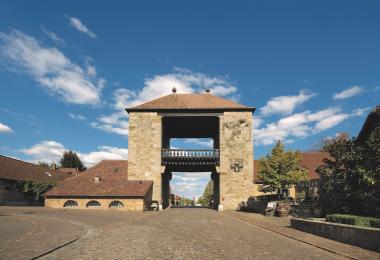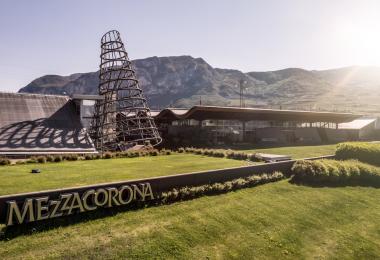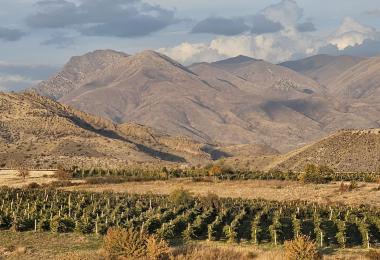When wine drinkers think about Piedmont, many think of red wines: Barbera, Barolo and Barbaresco. True wine lovers know to add one more name to the list – Gavi, popularly known as ‘the great white wine’ of Piedmont.
It owes its full name of Cortese di Gavi to two very different stories. One is obvious: Gavi is the small town at the centre of the wine’s production zone, so it makes sense for the wine to take the geographical name. Cortese is, of course, the variety of grape from which it is made.
But there is another, much more romantic explanation.
Gavia, daughter of Clodomir, King of the Franks, fled from her father’s court in the company of a young knight. Crossing the border into Piedmont, they found a place that was safe from the Frankish army and built a castle, to which she gave her name. ‘Cortese’ refers to Gavia’s courteous ways.
While the story is merely a legend, the grape itself has been honoured in the region since as long ago as 972AD. It’s always been associated with the nobility, because it was grown by the noble families of Genova who had properties in the area. An autochthonous variety, it was later used to replant the region after the ravages of Phylloxera.
Just what is it about this white grape that has made it so valued for more than 1,000 years?
Remarkable terroir
The historic area of the Gavi DOCG is the most southern region of Piedmont, lying between Liguria and Lombardy, around 30 kilometres from the sea.
Situated between the plain and the sea as it was, it functioned as a historic borderland, separating the Aleramic and Obertenga families who fought for control of Liguria and Lombardy. Gavi itself has always been of strategic importance, and its historic fortress is now a major tourist attraction. The town also played a role as a trading hub for Genoa, with important roads criss-crossing the territory. Today, it’s well-known for its links with fashion, sports, shopping and culture.
But it was the natural beauty of its undulating landscape of hills and valleys, covered in woods and vineyards that brought Genoa’s nobility to the area in search of a peaceful region in which to relax. The region today is dotted with impressive reminders of those families, including castles, villas and palaces. They also left behind their culinary heritage, a cuisine heavily tilted towards fish and vegetables. And the land beneath their feet was perfect for growing the native variety, Cortese, whose wines were a perfect match for their dinner.
Underlying the north of the region are red ferrous soils, of gravel mixed with clay, a legacy of ancient alluvial activity. In the central strip, alternating soils of marl and sandstone bind Gavi with Serravalle Scrivia and San Cristoforo. In the south are found fossil rich white soils, composed of clav-calcerous marls. This end of the Gavi DOCG lies in proximity to the Apennines, so the entire terroir is unique: sheltered vineyards, sea breezes, mountain snow and ancient soils.
Cortese is mainly grown in a hilly area of the southeast, part of the province of Alessandria. When vinified, it is pale straw-coloured in the glass with hints of green, and offers a taste of white flowers, bitter almonds and citrus. Its flavor is paradoxically round, yet dry and mineral. The Riserva is more golden and more intense, all while retaining the characteristic freshness.
Although plenty of intensive selection and viticulture has been done in recent decades to improve quality, there’s no doubt that Gavi was always highly valued historically. The first written record appears in 1659, when a farmer from Montaldeo Castle wrote of planting Cortese vines. In 1789, Marquis Giovanni Andrea Doria wrote to his manager about his intention to send the wine to America. That same year, Count Nuvolone, deputy director of the Turin Agrarian Society, included a description of Cortese in a study of the varieties grown in Piedmont, and in 1856, Marquis Cambiaso planted Cortese at his estates of La Centuriona and La Toledana.
The grape was clearly of great interest to people in the region, not just for its taste, but also because Cortese is disease resistant. In 1869 the ampelographic committee of the province of Alessandria declared it suitable for sparkling wine, and today, nearly 150 years later, frizzante, and spumante wines are produced from the 1,500 ha of vineyards surround Gavi, along with the still and Riserva examples with which people are most familiar.
Gavi has been a DOC since 1974. In 1998, it obtained the DOCG denomination. Today, more than 85% of the production is exported to more than 70 countries.
The defenders
The Consorzio Tutela del Gavi, founded in 1993, exists to support the entire supply chain, including producers, winemakers and bottlers. Since its founding, it been is one of Italy’s most productive and strategic consortiums, working to maintain and improve quality throughout the 11 municipalities included in the denomination. Its extensive efforts have ranged from the preparation of clonal selections to carrying out ampelographic and land surveys.
Wines from the region are sent to the media and given star treatment at international events. Since 2013, the Consortium has been working with the Italian Sommelier Association to undertake a blind tasting to choose the most representative Gavi for its institutional label.
To celebrate its fortieth birthday, the Consortium launched a new communication project in 2014, Storie del Gavi, il Grande Bianco Piemontese, a multisensory experience weaving storytelling, wine tasting, culture and food together, to showcase the treasures of this small corner of Piedmont to the world.
Feasting and celebration
Among the many events organized by the Consortium is the prestigious Gavi Prize LA BUONA ITALIA at the end of May, which recognises and rewards best practices in the enhancement of Italian food and wine. The annual shortlist is a veritable who’s who of Italy, including museums, artists, winemakers and tourist facilities.
Another important event is Di Gavi in Gavi, a festival that takes place on the last weekend in August, where the Gavi DOCG comes together with theatre, a parade, food and a light display to celebrate the past and future of the denomination.
This year the celebrations will be bigger still, because 2018 is the twentieth anniversary of the founding of the DOCG, when the Gavi DOCG cemented its place as the home of Italy’s great white wines.
Forty years of passion and dedication
1974 Gavi wine was awarded the
Controlled Designation of Origin.
1993 The Consorzio Tutela del Gavi was founded.
1997 The grapevine clonal selection
project was launched.
1998 Gavi wine becomes DOCG certified.
2002-
2004 The Consortium begins to systematically verify the grape vines belonging to the Gavi denomination. This immense project was the first of its kind to be undertaken by an Italian consortium.
2007 The Consortium develops detailed scientific maps of the territory.
2011 The GAVI 972 project is launched, to promote the region through social media.
(www.consorziogavi.com)
2014 The DOC turns 40 and a celebratory label is created.
2018 This year is the 20th anniversary of the DOCG and a special label will be launched.
The 11 districts of the production area:
- Bosio
- Carrosio
- Capriata d’Orba
- Francavilla Bisio
- Gavi
- Novi Ligure
- Parodi Ligure
- Pasturana
- San Cristoforo
- Serravalle Scrivia
- Tassarolo








